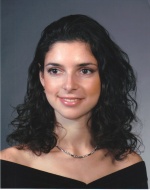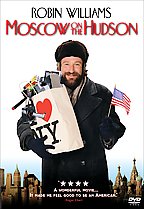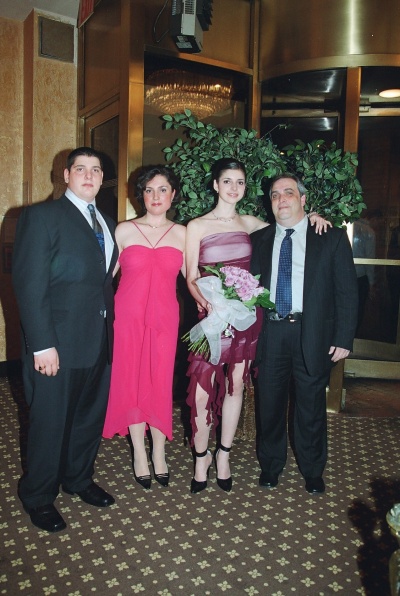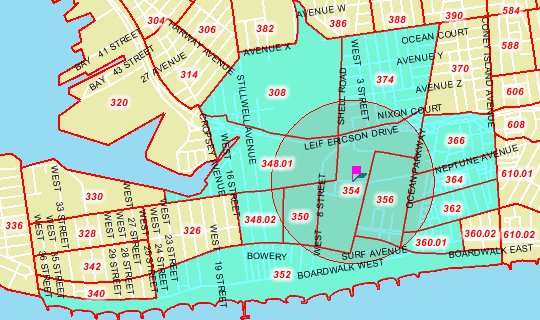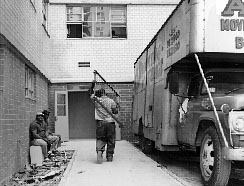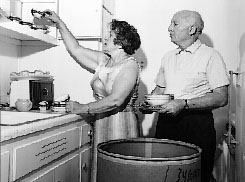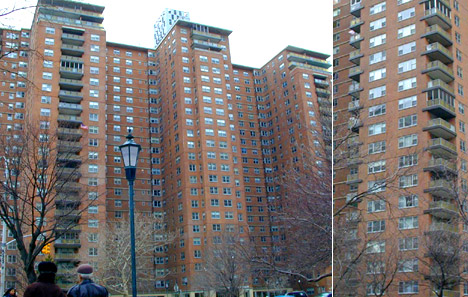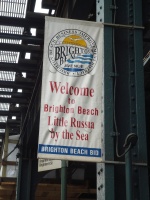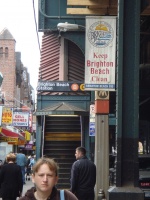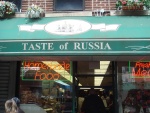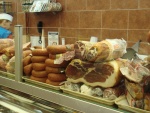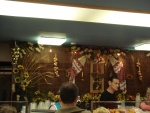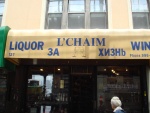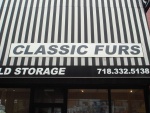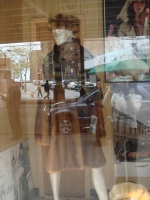User:RbassFrom The Peopling of New York CityRachel Bass
BiographyI am the first person in my entire extended family to be born in the United States. This fact has always pushed me to succeed. Knowing that my parents left their homeland for opportunity, I decided when I was very young that I would take advantage of all opportunities available to me. My decision is what brought me here today. In my freshman year of high school, I learned about the CUNY Honors College. I found out that it is a very prestigious program in which students’ don’t have to worry about tuition. This, and the impression of honors students’ forming a tight knit community within the college, enticed me. My goal through high school was to get into this program. Come senior year, I applied early decision to Brooklyn Honors College. I chose Brooklyn because out of all the CUNY schools, it is the most inviting and relaxed. Aside from its gorgeous campus, it is closest to home, not to mention directly across the street from the high school I graduated. I declared a major in public accounting. I chose accounting because it is stable and versatile. Out of all fields, job demand for accountants is greatest. With a degree in accounting, people can work in areas of finance and business. I hope to get my CPA, and if by that point I’m not worn out from studying, I’d like to go to law school and focus on corporate law. Outside of school, I devote a large portion of my time to my family and my boyfriend. I live with my parents and my seventeen-year old brother. For work, I tutor kids from elementary to high school level. I also help a few college students. I love to travel and my dream is to make a trip around the world. I am particularly infatuated with Europe, though I’d love to explore the middle east and the Orient as well. This summer I hope to study abroad in Rome and also squeeze in a trip to Israel.
Ideal CommunityIn an ideal community, inhabitants have a sense of identity and a feeling of home. It is a place where one would feel sheltered, wanted, and comfortable. A person living in an ideal community can travel the world and still say the clichéd “there is no place like home”. A good community offers convenience. It should have everything people need for everyday life. Public transportation, all sorts of stores, various restaurants, parks, good schools, and forms of diversion such as theatres should be nearby. I base an ideal community on my own community, Brighton Beach. I was born in Queens, where I lived most of my life, and then I moved to Staten Island for a short while. Though I’ve lived on Brighton only two years, it is the first community that I can truly call home. Perhaps it is because here, I can connect to my Russian roots. I walk two blocks from my house to a Russian foods store where the sales ladies know me by name. I can socialize with most of my neighbors, some of which knew even my great-grandparents in Ukraine. Here, I am exposed to the Russian culture that I was raised knowing. Brighton has everything a community can offer. Several trains and buses pass through it. It is a booming commercial center, where numerous shops and restaurants are always filled with customers. It also has a theatre, featuring international performances from the Russian ballet to Argentinean tango. Being that Brighton is adjacent to the beach and the boardwalk, there is always plenty of recreation. When inhabitants of a community don’t have much need or desire to leave it, and outsiders are attracted to it, I would say the community is ideal.
Moscow on the HudsonMoscow on the Hudson captures the essence of the immigration experience. Tired of his miserably oppressed life in the Soviet Union, Vladimir makes his escape by boldly declaring asylum in Bloomingdales. Defying his boss, he utters, “I defect” just inside the entrance of the crowded department store. The store’s opulence swayed Vladimir to come to this decision, opening his eyes to a world outside of his poor and restrictive homeland. After this heart touching scene, Vladimir is faced with the struggles that all poor immigrants must endure. Nevertheless, he sees that even with all its difficulties, America still offers him something that his native country deprived him of- freedom. And, unlike Russia, he sees that in America, through hard work and ambition he can shape his own future. I think that most immigrants who come to New York can relate to Vladimir’s experiences, motives, and emotions. There to HereBoth my parents are from Odessa, Ukraine (http://en.wikipedia.org/wiki/Odessa). They lived there under the oppressive regime of the Soviet Union. As Jews, they had very limited opportunities. Jews were considered second-class citizens, and were publicly degraded. Economic hardship was also inherent in Soviet life. People who were able to find jobs all had about the same meager salary, regardless of profession. This salary was not nearly enough to get by, so through connections people made their extra money illegally. Often, such activity led to jail. My grandmother worked as a nurse and my grandfather worked in leather production. Because of World War II, they never received an education, and money was always scarce. In 1977, as my father’s eighteenth birthday was approaching, his parents knew it was time to leave or give their son away to the notorious Russian Army. They decided to come to New York, following a relative who had already emigrated. They had a two-step immigration, first stopping in Rome for three months. My father fell in love with the city, for the first time experiencing freedom from the Soviet regime. The breath of fresh air that Rome provided for him occupies his nostalgia to this day. Upon arriving in New York, they settled in Flushing, Queens, which at the time was a primarily Jewish neighborhood. My mother left Odessa in 1978, at the age of nine. Her father was a very successful barber and hair stylist. Her mother was an engineer who pretended to be Christian in order to attend university. She worked at a confectionary factory, and always had enough to get by. Though they lived considerably comfortably, life was still unstable and tough. When my mother was a baby her father left for America, and nine years later she and her mother went to join him. They also stopped in Rome for three months, and then settled in Philadelphia, joining my grandfather. There was and still is a large Russian-Jewish community there. My grandparents had a salon there, and when my mom was seventeen, they moved to Brighton Beach to expand their business and cater to a larger Russian community. When my parents got married they settled in Flushing, in the same building that my father moved into upon arriving in the country. I was born in Flushing, and watched the community change as I grew up. An all -Jewish community morphed into an oriental and Arab haven. Slowly, we changed from being a common Flushing family to a minority. My parents saw this as a decline of the neighborhood. They longed for their sense of common identity in the community. They wanted to buy a house, and at the time, many Russians flocked to Staten Island to purchase affordable homes in up and coming building developments. So in 2002, we moved to Staten Island. Shortly, we found that conforming to suburban life wasn’t so easy. Staten Island was too isolated and dull for us. Since we were always in Brooklyn visiting family and friends, shopping, and going to the beach anyway, we decided to sell the house and move there. We now live by Brighton Beach, in the Warbasse community.
NeighborhoodBrighton Beach 545 NEPTUNE AVE., BROOKLYN Statistics Tract 354 in Kings County, NY Population 5,622 Pop. Density (per sq. mile) 39,086.1 Land Area (in sq. miles) 0.1 Sex Male 2,478 44.1% Female 3,144 55.9% Age Median Age 55.5 Race Non-Hispanic 5,481 97.5% American Indian 0 0% Asian 15 0.3% Black 175 3.1% Hawaiian/Pacific Is. 0 0% White 5,256 93.5% Other 7 0.1% 2+ Races 28 0.5% Hispanic 141 2.5% Hispanic Black 11 0.2% Hispanic White 84 1.5% Hispanic Other 46 0.8%
Native Born 2,848 50.7%
Foreign Born 2,774 49.3%
Europe 2,606 93.9%
Northern Europe 58 2.1%
United Kingdom 58 2.1%
Western Europe 30 1.1%
Austria 14 0.5%
Germany 16 0.6%
Southern Europe 11 0.4%
Italy 11 0.4%
Eastern Europe 2,507 90.4%
Czechoslovakia 14 0.5%
Hungary 8 0.3%
Poland 267 9.6%
Belarus 107 3.9%
Russia 965 34.8%
Ukraine 901 32.5%
Other E-Europe 245 8.8%
Asia 84 3.0%
South-Central Asia 30 1.1%
Western Asia 54 1.9%
Israel 15 0.5%
Other W-Asia 39 1.4%
Africa 8 0.3%
Egypt 8 0.3%
Americas 76 2.7%
Latin America 68 2.5%
Caribbean 50 1.8%
Haiti 19 0.7%
Jamaica 20 0.7%
Other Carib 11 0.4%
Central America 18 0.6%
Honduras 10 0.4%
Nicaragua 8 0.3%
Northern America 8 0.3%
Canada 8 0.3%
I live in community district 13, right off of Brighton Beach, in census tract 354, in the Warbasse community. My neighborhood is predominantly eastern European, particularly Russian and Ukranian. It is a mix of newly arrived immigrants and those who had settled in the U.S. at any point after the 1960's. There are people who have been here for years and still don't speak English, and there are those who were born in America and either forgot or never even learned the language of their mother country. The Warbasse housing in which I live is a government subsidized community. The five building high rise complex was built in the 1960's under the Mitchell-Lama Housing Program, a housing subsidy that aimed to provide affordable dwelling. Tenants are chosen randomly. Every so often, Warbasse holds a lottery that people can enter. If they win, they go on a long waiting list for an apartment. They can request one to three bedroom apartments. In order to qualify, annual family income must meet certain criteria relative to the type of apartment requested. The apartments are very affordable and commodious. Thus, no-one likes to leave and hopefuls can stay on the waiting list for many years before getting an apartment. For New York City, the community is pretty tight knit. The inhabitants are very friendly. Assimilated Americans, new and old Eastern European immigrants, hispanics, and blacks all get along. Warbasse holds frequent events and has an entire center dedicated to senior citizens and their needs. In addition, the location of the complex is convenient. It is within a two minute walk from various buses and trains. There is a large shopping plaza across the street from the buildings and the busy Brighton Beach Avenue is just a few blocks away. Not to mention, it is adjacent to the beach. The Soviet Jews in Brighton BeachUntil the Soviet influx, Brighton Beach was primarily inhabited by Yiddish speaking Jews from the first immigration wave. By 1980, Brighton Beach had become the largest Soviet immigrant community in the world. It was dubbed "Little Odessa" because three-quarters of Brighton's immigrants came from Ukraine, from cities around the Black Sea, such as Odessa. In the USSR, Jews were considered to be subordinate citizens. Two main push factors brought the Soviet Jews to America. The first reason was because of the increasingly tight restrictions on the number of Jews allowed in Soviet universities and training schools. Second was the shortage of food, clothing, and housewares. So they came for career opportunities and material sustenance. The first stop for Soviet Jewish emigrants was Vienna. There, they decided to go to either Israel or the U.S. If they chose to come to the U.S., they were flown to Rome by the Hebrew Immigrant Aid Society (HIAS) where they were housed and taught English while their immigration papers were processed. My parents went through this immigration, and the people in Orleck's essay describe this step as my parents do. "In Rome, we got our first taste of the west, and of freedom. We celebrated for three months," one immigrant recalls. After settling in New York, the immigrants were guided by NYANA, or the New York Association for New Americans. The agency came up with several neighborhoods to settle these immigrants, trying to find places with cheap housing, nearby transportation, and already established East European Jewish communities. Among the chosen venues were Brighton Beach, Washington Heights, Rego Park, and Williamsburg. Brighton Beach became the most popular in part for its proximity to the Atlantic Ocean. For immigrants from the Black Sea area, it is comforting to live by the sea and by Brighton's three mile stretch of beach that connects it with Coney Island. One Odessan immigrant said, "The first time I saw the Boardwalk and the beach, I decided I wanted to live here. It reminds me a little of home". The Soviet immigrants in fact changed the face of the old Yiddish community. Along the commercial fifteen blocks that Brighton Beach Avenue runs,Cyrillic letters replaced English and Yiddish ones. Newsstands sell more Russian newspapers than American ones, Russian owned "international style" food stores fill up the avenue, as well as Russian clothing stores, pharmacies, bookstores, and other specialty businesses. The Jewish immigrants from the first and second waves of immigration found ties with the Soviet Jews solely on the reality of being Jewish and having been persecuted for it. But the groups differ in their sense of Jewish identity. Soviet immigrants came from a deeply anti-semetic atmosphere of post World War II Soviet society. The Soviet regime restricted the teaching of Jewish religion or culture. Most people, therefore, knew nothing about their Jewishness, but at the same time they were never allowed to forget they were Jews. Jews were considered to be their own nationality. Soviet passports specified nationality as Russian, Ukrainian, or Jew. Passports were carried everywhere in those times, and having the letter J on an otherwise assimilated Jew's passport would result in harassment from government officials. That J would also keep Jews out of universities and restrict their freedom to travel. Most Jews wanted to escape the Soviet Union and leave the stigma of their Jewishness behind. When they came to Brighton, they experienced the opposite- the American Jews wanted to make them even more Jewish. One first-wave immigrant said, "We fought for them so they could live free as Jews, and here they are, they don't want to be Jews". With the influence of the American Jews, Soviet immigrants began to open up to public displays of Jewishness. For example, they began to publicly celebrate Jewish rites of passage with some attention to Jewish tradition. The details of such observances, however, seem mocking and irreligious to orthodox Jews. These ceremonies hold different meaning for these groups, but the revival of Jewish identity for Soviet Jews is an interesting adaptation of their immigration. Different age groups of Soviet immigrants relate to their Jewish identity and Soviet background in different ways. The transition to Brighton Beach was easiest for the elderly bthem Brighton was comfortable both physically and culturally. The elderly were able to socialize with the American Jews because they share a common language- Yiddish. Those born before World War II, before Stalin went full force in his anti- Jewish campaigns, spoke Yiddish. Although the elderly have not spoken it since the war, they were still able to remember it and used it to communicate to non-Russian speaking Jews on Brighton Beach. One Soviet immigrant said, "The first time I heard Yiddish spoken on the street here, I couldn't believe my ears. Then I saw little boys on the street wearing yarmulkes, unafraid, and I cried. Here when I hear Yiddish spoken freely, my heart feels better". Although most Soviet elderly are not religious, most retain a strong sense of secular Jewish identity. Soviet elders have become part of the larger senior citizen community on Brighton and socialize with elderly members of first and second wave groups in cultural organizations such as Shorefront Senior Center. They also socialize among themselves, most famously on the boardwalk or on chairs in front of their buildings. Soviet elders retain a system of child care where grandparents play an important part in bringing up their grandchildren. Grandparents basically take over caring for their grandkids so that the parents would be free to work or relax. This follows a tradition that does not believe in nannies or babysitters. Grandparents get a chance to be close to their families and provide a necessary service to their children. Though adjusting to American life can be hard for some elderly immigrants, Brighton makes the process easier. All seniors are given minimum Social Security benefits and access to reduced-cost senior citizen housing. They settle into a community that offers familiar foods and a familiar language. The middle aged Soviet immigrants have not had it so easy. They are well educated, most either being college or professional institute graduates or have technical training. Coming to America, they thought there would be no problem finding jobs suited to their skills. Coming from a nation that guarantees work for all trained professionals, they were shocked to have to compete for jobs in America. Many of these immigrants have experienced downward mobility in the United States because they lack sufficient knowledge of the English language. Also, licensing requirements differ in the U.S. Many immigrants hare not able to learn enough of the language to pass licensing exams in the U.S. Some Soviet professionals have either been bale to find work because of their English skills or within the Russian speaking community. Others become entrepreneurs. Many have opened up small businesses such as groceries, restaurants, dry cleaners, clothing stores, car services, travel agencies, etc. and hired fellow immigrants to work for them. Many started their businesses by getting loans from Jewish organizations, and Brighton now booms with them. Younger immigrants have had a much easier time adapting to New York. Immigrants who arrive as young children pick up English quickly without a trace of an accent. In fact, they often teach their parents English and act as translators when needed. Few remember much about their home country, and though they may speak Russian at home, they speak English amongst themselves. Most end up succeeding in New York City public schools, and, having a much more accelerated Soviet education, pick up quickly. Adjusting is harder for teenage immigrants, who, already set in their ways, feel they must change to fit in as Americans. The problem with that is, they are confused as to what an "American" is. The ethnic diversity in public schools makes it hard for them to figure out who exactly it is they must emulate to become more American. One teenage immigrant said, "Where are all the Americans? I haven't met any yet". As these young adults become surer of themselves, they develop identities that mix Russian, New York, Jewish, and American elements. Brighton's Russian restaurants provide a place for group gatherings. They are distinct from other kinds of restaurants. They are like private clubs where Soviet immigrants can gather to celebrate occasions or just come out to have a good time. They feature either banquet style or a la carte menus. Live bands with singers entertain guests all night on the dance floor. The music is a mix of contemporary American, Russian, and traditional Jewish songs. Each restaurant caters to a different regional taste, for example Odessa style, Caucus, style, or Uzbek style. These restaurants are the center of Soviet immigrant life. These restaurants stem from Soviet Jewish culture. It was both difficult and dangerous for Jews to gather in groups. These types of restaurants were among the very few places Jews could gather in a relaxed atmosphere. In America, gathering in these restaurants represents freedom and a good life. The restaurants are extravagant in both decor and the large, gourmet spreads of food they serve. Immigrants come to them dressed in fine, expensive clothing, which represents the life for which they came for. The open Jewish gatherings celebrate the freedom, even though they may not be all that Jewish. For example, at a typical Soviet Jewish Bar Mitzvah, the family will perform the ceremony right in the restaurant. Sometimes they will have a reformed rabbi come in, but it is usually just done by the host of the restaurant, however he or she knows how. After the symbolic ceremony and blessings, everyone sits down to eat the non kosher food and dance to traditional Yiddish music. At a Bar Mitzvah Orleck discusses, she has a guest explain the unusual ceremony. He said, "It is possible that we have forgotten everything about the Jewish religion. But we have not forgotten that we are Jews". Brighton is the only Jewish immigrant neighborhood in New York that contains immigrants of the first, second, and third wave Eastern European Jewish immigrants. The interaction and inter-mingling of these groups has produced a unique type of Jewish community life. |
